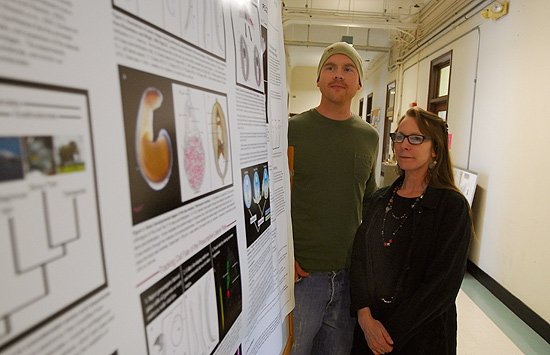Award Sends Graduate Student to Japan for Lamprey Study
 |
| At right, Ann Campbell Burke, associate professor of biology, and biology graduate student Frank Tulenko, look over Tulenko’s research poster explaining how lamprey embryos develop. Tulenko is continuing this research at the RIKEN Institute in Kobe, Japan this summer. |
| Posted 06/03/08 |
| In the past 350 million years of vertebrate evolution, the musculoskeletal system has morphed significantly across taxonomic groups. The first vertebrates, had no jaws or paired fins, and are represented today by the eel-like aquatic the lamprey that continues to thrive with its archaic cartilage jowls.
As a recipient of an East Asia and Pacific Summer Institutes for U.S. Graduate Students (EAPSI) award, biology graduate student Frank Tulenko is spending his summer studying how these primitive vertebrates develop. His study began June 1 at the RIKEN Institutes Center for Developmental Biology in Kobe, Japan. Franks research will give us better insight into how a vertebrates body is formed, explains Tulenkos advisor, Ann Campbell Burke, associate professor of biology. By studying this basal vertebrate, we can enrich our understanding of mesodermal patterning in our ancestors. At the RIKEN Center, Tulenko is conducting research with Shigeru Kuratani, director of the Laboratory for Evolutionary Morphology. Kuratani, a colleague of Burke, is an expert on jawless fishes known as agnathostomes. In collaboration with members of the Kuratani lab in Kobe, Tulenko will be part of research team tracking how cells move and develop in the lampreys early stages of life. The team will do this by injecting the embryos cells with vital dye. As the embryos develop into larvae, the researchers observe where certain cells move within the fishs skeletal muscles. Tulenko will be focusing specifically on the lateral plate mesoderm a cell population within the embryo that forms the skeleton, muscles, heart, spleen and other internal organs. Knowledge of the developmental morphologies of lampreys is critical to understanding how the vertebrate body plan has changed throughout time, Tulenko says. Since lamprey lack jaws and paired fins, the evolutionary position of lamprey makes it a key model system for gaining insight into the primitive characteristics of vertebrates. Burke says lamprey embryo research could ultimately contribute to human embryo studies. By studying the lamprey, we are learning how simple systems develop, and this could lead to understanding more about how birth defects occur in humans, Burke says. The East Asia and Pacific Summer Institutes provide U.S. graduate students in science and engineering a first-hand research experience, an introduction to the science and science policy infrastructure of the respective location; and orientation to the society, culture and language. The primary goals of EAPSI are to introduce students to East Asia and Pacific science and engineering in the context of a research setting, and to help students initiate scientific relationships that will better enable future collaboration with foreign counterparts. Tulenko applied for EAPSI in December 2007, and was notified of the award in February 2008. I was really excited to learn I was chosen, and have the opportunity to be immersed in non-western perspectives on science, Tulenko says. The institutes last approximately eight weeks from late June to August. Tulenko departed three weeks early to arrive in time for the lamprey spawning season. Although the research and experiments happen in a laboratory environment, its important to be there when they are spawning so we can collect the embryos fresh from the lampreys, Tulenko explains. At the end of his program, Tulenko hopes to write about his findings and submit them to an anatomy- or evolution-based science journal for publishing. Burke says his data could potentially lead to grant funding for additional lamprey development research. Burke believes Tulenko may be the first Wesleyan student to receive the (EAPSI) award, which is funded by the National Science Foundation (NSF). This really is an honor for Frank to get this award, Burke says. Its good for Frank, its good for Wesleyan and I hope this becomes the beginning of a long student-exchange and collaboration process between Wesleyan and the Kobe Institute. |
| By Olivia Drake, The Wesleyan Connection editor |

